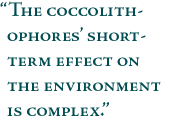

| What do they do to the environment? | |||
|
In the long term, the plants seem to be good for the environment. Coccolithophores make their coccoliths out of one part carbon, one part calcium and three parts oxygen (CaCO3). So each time a molecule of coccolith is made, one less carbon atom is allowed to roam freely in the world to form greenhouse gases and contribute to global warming. Three hundred twenty pounds of carbon go into every ton of coccoliths produced. All of this material sinks harmlessly to the bottom of the ocean to form sediment. The Coccolithophores' short-term effect on the environment is somewhat more complex. This effect again has to do with the formation of their coccoliths and the chemical reaction involved in the process. The chemical reaction that makes the coccolith also generates a carbon dioxide molecule, a potent greenhouse gas, from the oxygen and carbon already in the ocean. While much of the gas is sucked back in by the coccoliths (all plants take in carbon dioxide for food) some of it escapes into the atmosphere and immediately becomes part of the greenhouse gas problem. Scientists are concerned in the short term that greenhouse gases will cause the upper layers of the ocean to become more temperate and stagnant. This would increase the number of coccoliths in the world, which would produce more greenhouse gas. The Coccolithophores also affect the global climate in the short term by increasing the oceans' albedo. Albedo is the fraction of sunlight an object reflects--higher albedo values indicate more reflected light. Coccolithophore blooms reflect nearly all the visible light that hits them. Since most of this light is being reflected, less of it is being absorbed by the ocean and stored as heat. Above is an image taken from space, showing a coccolithophore bloom south of Iceland. Ocean currents and eddies can be seen in the swirls of aquamarine water. (Image courtesy Norman Kuring, SeaWiFS project)
|

| ||